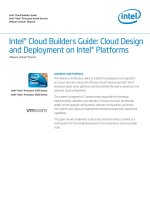cryptographic security architecture design and verification
Bạn đang xem bản rút gọn của tài liệu. Xem và tải ngay bản đầy đủ của tài liệu tại đây (2.69 MB, 339 trang )
Cryptographic Security
Architecture:
Design and Verification
Peter Gutmann
Springer
Cryptographic Security ArchitecturePeter Gutmann
Cryptographic Security
Architecture
Design and Verification
With 149 Illustrations
Peter Gutmann
Department of Computer Science
University of Auckland
Private Bag 92019
Auckland
New Zealand
Cover illustration: During the 16th and 17th centuries the art of fortress design advanced from ad hoc
methods which threw up towers and walls as needed, materials allowed, and fashion dictated, to a
science based on the use of rigorous engineering principles. This type of systematic security architec-
ture design was made famous by Sebastien le Prestre de Vauban, a portion of whose fortress of Neuf-
Brisach on the French border with Switzerland is depicted on the cover.
Library of Congress Cataloging-in-Publication Data
Gutmann, Peter.
Cryptographic Security Architecture / Peter Gutmann.
p. cm.
Includes bibliographical references and index.
ISBN 0-387-95387-6 (alk. paper)
1. Computer security. 2. Cryptography. I. Title.
QA76.9.A25 G88 2002
005.8—dc21 2002070742
ISBN 0-387-95387-6 Printed on acid-free paper.
2004 Springer-Verlag New York, Inc.
All rights reserved. This work may not be translated or copied in whole or in part without the written permission
of the publisher (Springer-Verlag New York, Inc., 175 Fifth Avenue, New York, NY 10010, USA), except for
brief excerpts in connection with reviews or scholarly analysis. Use in connection with any form of information
storage and retrieval, electronic adaptation, computer software, or by similar or dissimilar methodology now known
or hereafter developed is forbidden.
The use in this publication of trade names, trademarks, service marks, and similar terms, even if they are not
identified as such, is not to be taken as an expression of opinion as to whether or not they are subject to proprietary
rights.
Printed in the United States of America.
987654321 SPIN 10856194
Typesetting: Pages created using the author’s Word files.
www.springer-ny.com
Springer-Verlag New York Berlin Heidelberg
A member of BertelsmannSpringer Science+Business Media GmbH
John Roebling had sense enough to know what he
didn’t know. So he designed the stiffness of the
truss on the Brooklyn Bridge roadway to be six
times what a normal calculation based on known
static and dynamic loads would have called for.
When Roebling was asked whether his proposed
bridge wouldn’t collapse like so many others, he
said “No, because I designed it six times as strong
as it needs to be, to prevent that from happening”
— Jon Bentley, “Programming Pearls”
This page intentionally left blank
Preface
Overview and Goals
This book describes various aspects of cryptographic security architecture design, with a
particular emphasis on the use of rigorous security models and practices in the design. The
first portion of the book presents the overall architectural basis for the design, providing a
general overview of features such as the object model and inter-object communications. The
objective of this portion of the work is to provide an understanding of the software
architectural underpinnings on which the rest of the book is based.
Following on from this, the remainder of the book contains an analysis of security policies
and kernel design that are used to support the security side of the architecture. The goal of
this part of the book is to provide an awareness and understanding of various security models
and policies, and how they may be applied towards the protection of cryptographic
information and data. The security kernel design presented here uses a novel design that
bases its security policy on a collection of filter rules enforcing a cryptographic module-
specific security policy. Since the enforcement mechanism (the kernel) is completely
independent of the policy database (the filter rules), it is possible to change the behaviour of
the architecture by updating the policy database without having to make any changes to the
kernel itself. This clear separation of policy and mechanism contrasts with current
cryptographic security architecture approaches which, if they enforce controls at all, hardcode
them into the implementation, making it difficult to either change the controls to meet
application-specific requirements or to assess and verify them.
To provide assurance of the correctness of the implementation, this thesis presents a
design and implementation process that has been selected to allow the implementation to be
verified in a manner that can reassure an outsider that it does indeed function as required. In
addition to producing verification evidence that is understandable to the average user, the
verification process for an implementation needs to be fully automated and capable of being
taken down to the level of running code, an approach that is currently impossible with
traditional methods. The approach presented here makes it possible to perform verification at
this level, something that had previously been classed as “beyond A1” (that is, not achievable
using any known technology).
Finally, two specific issues that arise from the design presented here, namely the
generation and protection of cryptovariables such as encryption and signature keys, and the
application of the design to cryptographic hardware, are presented. These sections are
viii Preface
intended to supplement the main work and provide additional information on areas that are
often neglected in other works.
Organisation and Features
A cryptographic security architecture constitutes the collection of hardware and software that
protects and controls the use of encryption keys and similar cryptovariables. Traditional
security architectures have concentrated mostly on defining an application programming
interface (API) and left the internal details up to individual implementers. This book presents
a design for a portable, flexible high-security architecture based on a traditional computer
security model. Behind the API it consists of a kernel implementing a reference monitor that
controls access to security-relevant objects and attributes based on a configurable security
policy. Layered over the kernel are various objects that abstract core functionality such as
encryption and digital signature capabilities, certificate management, and secure sessions and
data enveloping (email encryption). This allows them to be easily moved into cryptographic
devices such as smart cards and crypto accelerators for extra performance or security. Chapter
1 introduces the software architecture and provides a general overview of features such as the
object model and inter-object communications.
Since security-related functions that handle sensitive data pervade the architecture,
security must be considered in every aspect of the design. Chapter 2 provides a
comprehensive overview of the security features of the architecture, beginning with an
analysis of requirements and an introduction to various types of security models and security
kernel design, with a particular emphasis on separation kernels of the type used in the
architecture. The kernel contains various security and protection mechanisms that it enforces
for all objects within the architecture, as covered in the latter part of the chapter.
The kernel itself uses a novel design that bases its security policy on a collection of filter
rules enforcing a cryptographic module-specific security policy. The implementation details
of the kernel and its filter rules are presented in Chapter 3, which first examines similar
approaches used in other systems and then presents the kernel design and implementation
details of the filter rules.
Since the enforcement mechanism (the kernel) is completely independent of the policy
database (the filter rules), it is possible to change the behaviour of the architecture by
updating the policy database without having to make any changes to the kernel itself. This
clear separation of policy and mechanism contrasts with current cryptographic security
architecture approaches that, if they enforce controls at all, hardcode them into the
implementation, making it difficult either to change the controls to meet application-specific
requirements or to assess and verify them. The approach to enforcing security controls that is
presented here is important not simply for aesthetic reasons but also because it is crucial to
the verification process discussed in Chapter 5.
Once a security system has been implemented, the traditional (in fact, pretty much the
only) means of verifying the correctness of the implementation has been to apply various
Preface ix
approaches based on formal methods. This has several drawbacks, which are examined in
some detail in Chapter 4. This chapter covers various problems associated not only with
formal methods but with other possible alternatives as well, concluding that neither the
application of formal methods nor the use of alternatives such as the CMM present a very
practical means of building high-assurance security software.
Rather than taking a fixed methodology and trying to force-fit the design to fit the
methodology, this book instead presents a design and implementation process that has been
selected to allow the design to be verified in a manner that can reassure an outsider that it
does indeed function as required, something that is practically impossible with a formally
verified design. Chapter 5 presents a new approach to building a trustworthy system that
combines cognitive psychology concepts and established software engineering principles.
This combination allows evidence to support the assurance argument to be presented to the
user in a manner that should be both palatable and comprehensible.
In addition to producing verification evidence that is understandable to the average user,
the verification process for an implementation needs to be fully automated and capable of
being taken down to the level of running code, an approach that is currently impossible with
traditional methods. The approach presented here makes it possible to perform verification at
this level, something that had previously been classed as “beyond A1” (that is, not achievable
using any known technology). This level of verification can be achieved principally because
the kernel design and implementation have been carefully chosen to match the functionality
embodied in the verification mechanism. The behaviour of the kernel then exactly matches
the functionality provided by the verification mechanism and the verification mechanism
provides exactly those checks that are needed to verify the kernel. The result of this co-
design process is an implementation for which a binary executable can be pulled from a
running system and re-verified against the specification at any point, a feature that would be
impossible with formal-methods-based verification.
The primary goal of a cryptographic security architecture is to safeguard cryptovariables
such as keys and related security parameters from misuse. Sensitive data of this kind lies at
the heart of any cryptographic system and must be generated by a random number generator
of guaranteed quality and security. If the cryptovariable generation process is insecure then
even the most sophisticated protection mechanisms in the architecture won’t do any good.
More precisely, the cryptovariable generation process must be subject to the same high level
of assurance as the kernel itself if the architecture is to meet its overall design goal, even
though it isn’t directly a part of the security kernel.
Because of the importance of this process, an entire chapter is devoted to the topic of
generating random number for use as cryptovariables. Chapter 6 begins with a requirements
analysis and a survey of existing generators, including extensive coverage of pitfalls that must
be avoided. It then describes the method used by the architecture to generate cryptovariables,
and applies the same verification techniques used in the kernel to the generator. Finally, the
performance of the generator on various operating systems is examined.
Although the architecture works well enough in a straightforward software-only
implementation, the situation where it really shines is when it is used as the equivalent of an
x Preface
operating system for cryptographic hardware (rather than having to share a computer with all
manner of other software, including trojan horses and similar malware). Chapter 7 presents a
sample application in which the architecture is used with a general-purpose embedded
system, with the security kernel acting as a mediator for access to the cryptographic
functionality embedded in the device. This represents the first open-source cryptographic
processor, and is capable of being built from off-the-shelf hardware controlled by the
software that implements the architecture.
Because the kernel is now running in a separate physical device, it is possible for it to
perform additional actions and checks that are not feasible in a general-purpose software
implementation. The chapter covers some of the threats that a straightforward software
implementation is exposed to, and then examines ways in which a cryptographic coprocessor
based on the architecture can counter these threats. For example, it can use a trusted I/O path
to request confirmation for actions such as document signing and decryption that would
otherwise be vulnerable to manipulation by trojan horses running in the same environment as
a pure software implementation.
Finally, the conclusion looks at what has been achieved, and examines avenues for future
work.
Intended Audience
This book is intended for a range of readers interested in security architectures, cryptographic
software and hardware, and verification techniques, including:
• Designers and implementers: The book discusses in some detail design issues
and approaches to meeting various security requirements.
• Students and researchers: The book is intended to be both a general tutorial for
study and an in-depth reference providing links to detailed background material
for further research.
Acknowledgements
This book (in its original thesis form) has been a long time in coming. My thesis supervisor,
Dr. Peter Fenwick, had both the patience to await its arrival and the courage to let me do my
own thing, with occasional course corrections as some areas of research proved to be more
fruitful than others. I hope that the finished work rewards his confidence in me.
I spent the last two years of my thesis as a visiting scientist at the IBM T.J. Watson
Research Centre in Hawthorne, New York. During that time the members of the global
security analysis lab (GSAL) and the smart card group provided a great deal of advice and
feedback on my work, augmented by the considerable resources of the Watson research
Preface xi
library. Leendert van Doorn, Paul Karger, Elaine and Charles Palmer, Ron Perez, Dave
Safford, Doug Schales, Sean Smith, Wietse Venema, and Steve Weingart all helped
contribute to the final product, and in return probably found out more about lobotomised
flatworms and sheep than they ever cared to know.
Before coming to IBM, Orion Systems in Auckland, New Zealand, for many years
provided me with a place to drink Mountain Dew, print out research papers, and test various
implementations of the work described in this book. Paying me wages while I did this was a
nice touch, and helped keep body and soul together.
Portions of this work have appeared both as refereed conference papers and in online
publications. Trent Jaeger, John Kelsey, Bodo Möller, Brian Oblivion, Colin Plumb, Geoff
Thorpe, Jon Tidswell, Robert Rothenburg Walking-Owl, Chris Zimman, and various
anonymous conference referees have offered comments and suggestions that have improved
the quality of the result. As the finished work neared completion, Charles “lint” Palmer,
Trent “gcc –wall” Jaeger and Paul “lclint” Karger went through various chapters and pointed
out sections where things could be clarified and improved.
Finally, I would like to thank my family for their continued support while I worked on my
thesis. After its completion, the current book form was prepared under the guidance and
direction of Wayne Wheeler and Wayne Yuhasz of Springer-Verlag. During the reworking
process, Adam Back, Ariel Glenn, and Anton Stiglic provided feedback and suggestions for
changes. The book itself was completed despite Microsoft Word, with diagrams done using
Visio.
Auckland, New Zealand, May 2002
This page intentionally left blank
Contents
Preface vii
Overview and Goals vii
Organisation and Features viii
Intended Audience x
Acknowledgements x
1 The Software Architecture 1
1.1 Introduction 1
1.2 An Introduction to Software Architecture 2
1.2.1 The Pipe-and-Filter Model 3
1.2.2 The Object-Oriented Model 4
1.2.3 The Event-Based Model 5
1.2.4 The Layered Model 6
1.2.5 The Repository Model 6
1.2.6 The Distributed Process Model 7
1.2.7 The Forwarder-Receiver Model 7
1.3 Architecture Design Goals 8
1.4 The Object Model 9
1.4.1 User l Object Interaction 10
1.4.2 Action Objects 12
1.4.3 Data Containers 13
1.4.4 Key and Certificate Containers 14
1.4.5 Security Attribute Containers 15
1.4.6 The Overall Architectural and Object Model 15
1.5 Object Internals 17
1.5.1 Object Internal Details 18
1.5.2 Data Formats 20
1.6 Interobject Communications 21
1.6.1 Message Routing 23
1.6.2 Message Routing Implementation 25
1.6.3 Alternative Routing Strategies 26
1.7 The Message Dispatcher 27
1.7.1 Asynchronous versus Synchronous Message Dispatching 30
1.8 Object Reuse 31
1.8.1 Object Dependencies 34
xiv Contents
1.9 Object Management Message Flow 35
1.10 Other Kernel Mechanisms 37
1.10.1 Semaphores 38
1.10.2 Threads 38
1.10.3 Event Notification 39
1.11 References 39
2 The Security Architecture 45
2.1 Security Features of the Architecture 45
2.1.1 Security Architecture Design Goals 46
2.2 Introduction to Security Mechanisms 47
2.2.1 Access Control 47
2.2.2 Reference Monitors 49
2.2.3 Security Policies and Models 49
2.2.4 Security Models after Bell–LaPadula 51
2.2.5 Security Kernels and the Separation Kernel 54
2.2.6 The Generalised TCB 57
2.2.7 Implementation Complexity Issues 59
2.3 The cryptlib Security Kernel 61
2.3.1 Extended Security Policies and Models 63
2.3.2 Controls Enforced by the Kernel 65
2.4 The Object Life Cycle 66
2.4.1 Object Creation and Destruction 68
2.5 Object Access Control 70
2.5.1 Object Security Implementation 72
2.5.2 External and Internal Object Access 74
2.6 Object Usage Control 75
2.6.1 Permission Inheritance 76
2.6.2 The Security Controls as an Expert System 77
2.6.3 Other Object Controls 78
2.7 Protecting Objects Outside the Architecture 79
2.7.1 Key Export Security Features 81
2.8 Object Attribute security 82
2.9 References 83
3 The Kernel Implementation 93
3.1 Kernel Message Processing 93
3.1.1 Rule-based Policy Enforcement 93
3.1.2 The DTOS/Flask Approach 94
3.1.3 Object-based Access Control 96
3.1.4 Meta-Objects for Access Control 98
3.1.5 Access Control via Message Filter Rules 99
3.2 Filter Rule Structure 101
Contents xv
3.2.1 Filter Rules 102
3.3 Attribute ACL Structure 106
3.3.1 Attribute ACLs 108
3.4 Mechanism ACL Structure 112
3.4.1 Mechanism ACLs 113
3.5 Message Filter Implementation 117
3.5.1 Pre-dispatch Filters 117
3.5.2 Post-dispatch Filters 119
3.6 Customising the Rule-Based Policy 120
3.7 Miscellaneous Implementation Issues 122
3.8 Performance 123
3.9 References 123
4 Verification Techniques 127
4.1 Introduction 127
4.2 Formal Security Verification 127
4.2.1 Formal Security Model Verification 130
4.3 Problems with Formal Verification 131
4.3.1 Problems with Tools and Scalability 131
4.3.2 Formal Methods as a Swiss Army Chainsaw 133
4.3.3 What Happens when the Chainsaw Sticks 135
4.3.4 What is being Verified/Proven? 138
4.3.5 Credibility of Formal Methods 142
4.3.6 Where Formal Methods are Cost-Effective 144
4.3.7 Whither Formal Methods? 145
4.4 Problems with other Software Engineering Methods 146
4.4.1 Assessing the Effectiveness of Software Engineering Techniques 149
4.5 Alternative Approaches 152
4.5.1 Extreme Programming 153
4.5.2 Lessons from Alternative Approaches 154
4.6 References 154
5 Verification of the cryptlib Kernel 167
5.1 An Analytical Approach to Verification Methods 167
5.1.1 Peer Review as an Evaluation Mechanism 168
5.1.2 Enabling Peer Review 170
5.1.3 Selecting an Appropriate Specification Method 170
5.1.4 A Unified Specification 173
5.1.5 Enabling Verification All the way Down 174
5.2 Making the Specification and Implementation Comprehensible 175
5.2.1 Program Cognition 176
5.2.2 How Programmers Understand Code 177
5.2.3 Code Layout to Aid Comprehension 180
xvi Contents
5.2.4 Code Creation and Bugs 182
5.2.5 Avoiding Specification/Implementation Bugs 183
5.3 Verification All the Way Down 184
5.3.1 Programming with Assertions 186
5.3.2 Specification using Assertions 188
5.3.3 Specification Languages 189
5.3.4 English-like Specification Languages 190
5.3.5 Spec 192
5.3.6 Larch 193
5.3.7 ADL 194
5.3.8 Other Approaches 197
5.4 The Verification Process 199
5.4.1 Verification of the Kernel Filter Rules 199
5.4.2 Specification-Based Testing 200
5.4.3 Verification with ADL 202
5.5 Conclusion 203
5.6 References 204
6 Random Number Generation 215
6.1 Introduction 215
6.2 Requirements and Limitations of the Generator 218
6.3 Existing Generator Designs and Problems 221
6.3.1 The Applied Cryptography Generator 223
6.3.2 The ANSI X9.17 Generator 224
6.3.3 The PGP 2.x Generator 225
6.3.4 The PGP 5.x Generator 227
6.3.5 The /dev/random Generator 228
6.3.6 The Skip Generator 230
6.3.7 The ssh Generator 231
6.3.8 The SSLeay/OpenSSL Generator 232
6.3.9 The CryptoAPI Generator 235
6.3.10 The Capstone/Fortezza Generator 236
6.3.11 The Intel Generator 238
6.4 The cryptlib Generator 239
6.4.1 The Mixing Function 239
6.4.2 Protection of Pool Output 240
6.4.3 Output Post-processing 242
6.4.4 Other Precautions 242
6.4.5 Nonce Generation 242
6.4.6 Generator Continuous Tests 243
6.4.7 Generator Verification 244
6.4.8 System-specific Pitfalls 245
6.4.9 A Taxonomy of Generators 248
6.5 The Entropy Accumulator 249
Contents xvii
6.5.1 Problems with User-Supplied Entropy 249
6.5.2 Entropy Polling Strategy 250
6.5.3 Win16 Polling 251
6.5.4 Macintosh and OS/2 Polling 251
6.5.5 BeOS Polling 252
6.5.6 Win32 Polling 252
6.5.7 Unix Polling 253
6.5.8 Other Entropy Sources 256
6.6 Randomness-Polling Results 256
6.6.1 Data Compression as an Entropy Estimation Tool 257
6.6.2 Win16/Windows 95/98/ME Polling Results 259
6.6.3 Windows NT/2000/XP Polling Results 260
6.6.4 Unix Polling Results 261
6.7 Extensions to the Basic Polling Model 261
6.8 Protecting the Randomness Pool 263
6.9 Conclusion 266
6.10 References 267
7 Hardware Encryption Modules 275
7.1 Problems with Crypto on End-User Systems 275
7.1.1 The Root of the Problem 277
7.1.2 Solving the Problem 279
7.1.3 Coprocessor Design Issues 280
7.2 The Coprocessor 283
7.2.1 Coprocessor Hardware 283
7.2.2 Coprocessor Firmware 285
7.2.3 Firmware Setup 286
7.3 Crypto Functionality Implementation 287
7.3.1 Communicating with the Coprocessor 289
7.3.2 Communications Hardware 289
7.3.3 Communications Software 290
7.3.4 Coprocessor Session Control 291
7.3.5 Open versus Closed-Source Coprocessors 293
7.4 Extended Security Functionality 294
7.4.1 Controlling Coprocessor Actions 294
7.4.2 Trusted I/O Path 295
7.4.3 Physically Isolated Crypto 296
7.4.4 Coprocessors in Hostile Environments 297
7.5 Conclusion 299
7.6 References 299
8 Conclusion 305
8.1 Conclusion 305
xviii Contents
8.1.1 Separation Kernel Enforcing Filter Rules 305
8.1.2 Kernel and Verification Co-design 306
8.1.3 Use of Specification-based Testing 306
8.1.4 Use of Cognitive Psychology Principles for Verification 307
8.1.5 Practical Design 307
8.2 Future Research 308
9 Glossary 309
Index 317
1 The Software Architecture
1.1 Introduction
Traditional security toolkits have been implemented using a “collection of functions” design
in which each encryption capability is wrapped up in its own set of functions. For example
there might be a “load a DES key” function, an “encrypt with DES in CBC mode” function, a
“decrypt with DES in CFB mode” function, and so on [1][2]. More sophisticated toolkits
hide the plethora of algorithm-specific functions under a single set of umbrella interface
functions with often complex algorithm-selection criteria, in some cases requiring the setting
of up to a dozen parameters to select the mode of operation [3][4][5][6]. Either approach
requires that developers tightly couple the application to the underlying encryption
implementation, requiring a high degree of cryptographic awareness from developers and
forcing each new algorithm and application to be treated as a distinct development. In
addition, there is the danger — in fact almost a certainty due to the tricky nature of
cryptographic applications and the subtle problems arising from them — that the
implementation will be misused by developers who aren’t cryptography experts, when it
could be argued that it is the task of the toolkit to protect developers from making these
mistakes [7].
Alternative approaches concentrate on providing functionality for a particular type of
service such as authentication, integrity, or confidentiality. Some examples of this type of
design are the GSS-API [8][9][10], which is session-oriented and is used to control session-
style communications with other entities (an example implementation consists of a set of
GSS-API wrapper functions for Kerberos), the OSF DCE security API [11], which is based
around access control lists and secure RPC, and IBM’s CCA, which provides security
services for the financial industry [12]. Further examples include the SESAME API [13],
which is based around a Kerberos derivative with various enhancements such as X.509
certificate support, and the COE SS API [14], which provides GSS-API-like functionality
using a wrapper for the Netscape SSL API and is intended to be used in the Defence
Information Infrastructure (DII) Common Operating Environment (COE).
This type of design typically includes features specific to the required functionality. In
the case of the session-oriented interfaces mentioned above this is the security context that
contains details of a relationship between peers based on credentials established between the
peers. A non-session-based variant is the IDUP-GSS-API [15], which attempts to stretch the
GSS-API to cover store-and-forward use (this would typically be used for a service such as
email protection). Although these high-level APIs require relatively little cryptographic
awareness from developers, the fact that they operate only at a very abstract level makes it
difficult to guarantee interoperability across different security services. For example, the
2 1 The Software Architecture
DCE and SESAME security APIs, which act as a programming interface to a single type of
security service, work reasonably well in this role, but the GSS-API, which is a generic
interface, has seen a continuing proliferation of “management functions” and “support calls”
that allow the application developer to dive down into the lower layers of the code in a
somewhat haphazard manner [16]. Since individual vendors can use this to extend the
functionality in a vendor-specific manner, the end result is that one vendor’s GSS-API
implementation can be incompatible with a similar implementation from another vendor.
Both of these approaches represent an outside-in approach that begins with a particular
programming interface and then bolts on whatever is required to implement the functionality
in the interface. This work presents an alternative inside-out design that first builds a general
crypto/security architecture and then wraps a language-independent interface around it to
make particular portions of the architecture available to the user. In this case, it is important
to distinguish between the architecture and the API used to interface to it. With most
approaches the API is the architecture, whereas the approach presented in this work
concentrates on the internal architecture only. Apart from the very generic APKI [17] and
CISS [18][19][20][21] requirements, only CDSA [22][23] appears to provide a general
architecture design, and even this is presented at a rather abstract level and defined mostly in
terms of the API used to access it.
In contrast to these approaches, the design presented here begins by establishing a
software architectural model that is used to encapsulate various types of functionality such as
encryption and certificate management. The overall design goals for the architecture, as well
as the details of each object class, are presented in this chapter. Since the entire architecture
has very stringent security requirements, the object model requires an underlying security
kernel capable of supporting it — one that includes a means of mediating access to objects,
controlling the way this access is performed (for example, the manner in which object
attributes may be manipulated), and ensuring strict isolation of objects (that is, ensuring that
one object can’t influence the operation of another object in an uncontrolled manner). The
security aspects of the architecture are covered in the following chapters, although there is
occasional reference to them earlier where this is unavoidable.
1.2 An Introduction to Software Architecture
The field of software architecture is concerned with the study of large-grained software
components, their properties and relationships, and their patterns of combination. By
analysing properties shared across different application areas, it’s possible to identify
commonalities among them that may be candidates for the application of a generic solution
architecture [24][25].
A software architecture can be defined as a collection of components and a description of
the interaction and constraints on interaction between these components, typically represented
visually as a graph in which the components are the graph nodes and the connections that
handle interactions between components are the arcs [26][27]. The connections can take a
variety of forms, including procedure calls, event broadcast, pipes, and assorted message-
passing mechanisms.
1.2 An Introduction to Software Architecture 3
Software architecture descriptions provide a means for system designers to document
existing, well-proven design experience and to communicate information about the behaviour
of a system to people working with it, to “distil and provide a means to reuse the design
knowledge gained by experienced practitioners” [28]. For example, by describing a
particular architecture as a pipe-and-filter model (see Section 1.2.1), the designer is
communicating the fact that the system is based on stream transformations and that the
overall behaviour of the system arises from the composition of the constituent filter
components. Although the actual vocabulary used can be informal, it can convey
considerable semantic content to the user, removing the need to provide a lengthy and
complicated description of the solution [29]. When architecting a system, the designer can
rely on knowledge of how systems designed to perform similar tasks have been designed in
the past. The resulting architecture is the embodiment of a set of design decisions, each one
admitting one set of subsequent possibilities and discarding others in response to various
constraints imposed by the problem space, so that a particular software architecture can be
viewed as the architect’s response to the operative constraints [30]. The architectural model
created by the architect serves to document their vision for the overall software system and
provides guidance to others to help them avoid violating the vision if they need to extend and
modify the original architecture at a later date. The importance of architectural issues in the
design process has been recognised by organisations such as the US DoD, who are starting to
require contractors to address architectural considerations as part of the software acquisition
process [31].
This section contains an overview of the various software architecture models employed
in the cryptlib architecture.
1.2.1 The Pipe-and-Filter Model
The architectural abstraction most familiar to Unix
1
users is the pipe and filter model, in
which a component reads a data stream on its input and produces a data stream on its output,
typically transforming the data in some manner in the process (another analogy that has been
used for this architectural model is that of a multi-phase compiler [32]). This architecture,
illustrated in Figure 1.1, has the property that components don’t share any state with other
components, and aren’t even aware of the identities of any upstream or downstream
neighbours.
Component Component Component
tr -d ^[A-Za-z] uniq
sort
||
Figure 1.1. Pipe-and-filter model.
1
Unix is or has been at various times a trademark of AT&T Bell Laboratories, Western Electric, Novell,
Unix System Laboratories, the X/Open Consortium, the Open Group, the Trilateral Commission, and
the Bavarian Illuminati.
4 1 The Software Architecture
Since all components in a pipe-and-filter model are independent, a complete system can
be built through the composition of arbitrarily connected individual components, and any of
them can be replaced at any time with another component that provides equivalent
functionality. In the example in Figure 1.1, tr might be replaced with sed, or the sort
component with a more efficient version, without affecting the functioning of the overall
architecture.
The flexibility of the pipe-and-filter model has some accompanying disadvantages,
however. The “pipe” part of the architecture restricts operations to batch-sequential
processing, and the “filter” part restricts operations to those of a transformational nature.
Finally, the generic nature of each filter component may add additional work as each one has
to parse and interpret its data, leading to a loss in efficiency as well as increased
implementation complexity of individual components.
1.2.2 The Object-Oriented Model
This architectural model encapsulates data and the operations performed on it inside an object
abstract data type that interacts with other objects through function or method invocations or,
at a slightly more abstract level, message passing. In this model, shown in Figure 1.2, each
object is responsible for preserving the integrity of its internal representation, and the
representation itself is hidden from outsiders.
Method
Method
Method
Data
Invocation
Figure 1.2. Object-oriented model.
Object-oriented systems have a variety of useful properties such as providing data
abstraction (providing to the user essential details while hiding inessential ones), information
hiding (hiding details that don’t contribute to its essential characteristics such as its internal
structure and the implementation of its methods, so that the module is used via its
specification rather than its implementation), and so on. Inheritance, often associated with
object-oriented models, is an organisational principle that has no direct architectural function
[33] and won’t be discussed here.
The most significant disadvantage of an object-oriented model is that each object must be
aware of the identity of any other objects with which it wishes to interact, in contrast to the
pipe-and-filter model in which each component is logically independent from every other
1.2 An Introduction to Software Architecture 5
component. The effect of this is that each object may need to keep track of a number of other
objects with which it needs to communicate in order to perform its task, and a change in an
object needs to be communicated to all objects that reference it.
1.2.3 The Event-Based Model
An event-based architectural model uses a form of implicit invocation in which components
interact through event broadcasts that are processed as appropriate by other components,
which either register an interest in a particular event or class of events, or listen in on all
events and act on those which apply to the component. An example of an event-based model
as employed in a graphical windowing system is shown in Figure 1.3, in which a mouse click
event is forwarded to those components for which it is appropriate.
W indow
W indow
Printer
Disk
Mouse
click
Figure 1.3. Event-based model.
The main feature of this type of architecture is that, unlike the object-oriented model,
components don’t need to be aware of the identities of other components that will be affected
by the events. This advantage over the object-oriented model is, however, also a
disadvantage since a component can never really know which other components will react to
an event, and in which way they will react. An effect of this, which is seen in the most visible
event-based architecture, graphical windowing systems, is the problem of multiple
components reacting to the same event in different and conflicting ways under the assumption
that they have exclusive rights to the event. This problem leads to the creation of complex
processing rules and requirements for events and event handlers, which are often both
difficult to implement and work with, and don’t quite function as intended.
The problem is further exacerbated by some of the inherent shortcomings of event-based
models, which include nondeterministic processing of events (a component has no idea which
other components will react to an event, the manner in which they will react, or when they
will have finished reacting), and data-handling issues (data too large to be passed around as
6 1 The Software Architecture
part of the event notification must be held in some form of shared repository, leading to
problems with resource management if multiple event handlers try to manipulate it).
1.2.4 The Layered Model
The layered architecture model is based on a hierarchy of layers, with each layer providing
service to the layer above it and acting as a client to the layer below it. A typical layered
system is shown in Figure 1.4. Layered systems support designs based on increasing levels
of abstraction, allowing a complex problem to be broken down into a series of simple steps
and attacked using top-down or bottom-up design principles. Because each layer (in theory)
interacts only with the layers above and below it, changes in one layer affect at most two
other layers. As with abstract data types and filters, implementations of one layer can be
swapped with different implementations provided they export the same interface to the
surrounding layers.
Macro virus
W ord doc
MIME
SMTP
TCP
IP
Ethernet
Figure 1.4. Typical seven-layer model.
Unfortunately, decomposition of a system into discrete layers isn’t quite this simple, since
even if a system can somehow be abstracted into logically separate layers, performance and
implementation considerations often necessitate tight coupling between layers, or
implementations that span several layers. The ISO reference model (ISORM) provides a
good case study of all of the problems that can beset layered architectures [34].
1.2.5 The Repository Model
The repository model is composed of two different components: a central scoreboard-style
data structure which represents the current state of the repository, and one or more









